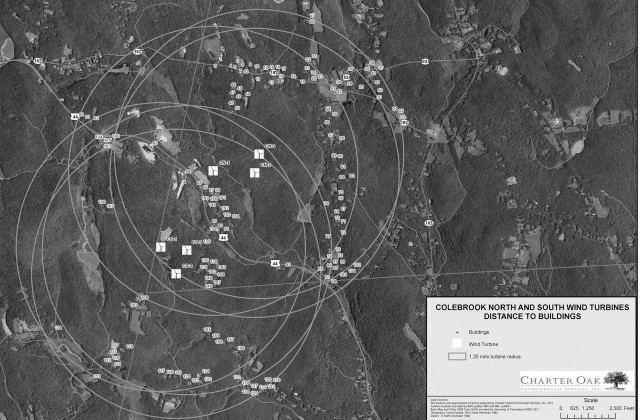A Long-Winded Affair
Despite challenges, BNE gets approval for a larger wind turbine installation
By Veronica Burns
Work is slowly proceeding at the Flagg Hill sites of the BNE Energy wind farm. A recent monitoring report on Wind Colebrook South states that “some work has resumed on site, they are clearing and grubbing for the revised road alignment & Site 2 location.” BNE chairman, Paul Corey, says they wanted to “lock in” the wind production tax credits before they expired at the end of 2013 and so have been doing some construction work. “Right now,” he says, “we are stabilizing everything.”
Meantime, there have been some changes afoot. In December, BNE submitted a modification to its Wind Colebrook South plan, stating that the manufacturing company, General Electric (GE), no longer produces the 1.6 megawatts (MV) turbine proposed in the original application. Immediately, attorneys for FairWindCT, Sukey Wagner and Stella and Michael Somers, submitted an objection listing various legal challenges, including a claim that the 1.6 MV turbine is still available. BNE is insistent however and considers the newer model better. “Visually,” says Corey, “you would not be able to tell the difference. They are similar in size and there are no additional environmental issues with them. They are also quieter.” According to GE’s literature, serrations on the blades reduce the noise.
The attorneys asserted that since BNE did not submit noise and shadow flicker impact studies for the new turbines, the request should be denied. The legal objections carried no weight with the council however and the modification was approved. Joyce Hemingson of FairwindCT seemed less than surprised. “I don’t think,” she says, “ that the siting council has learned much about wind turbines these past three years.”
The lack of wind regulations has become somewhat of a political football. In September, a legislative panel again rejected the siting council’s proposed regulations and a follow-up meeting was held to try to resolve differences. Concerns center on setback distances, the council retaining the right to waive certain requirements, decommissioning plans (specifically security bonding) and the role of municipalities. Betsy Gara, executive director of the Council of Small Towns would like to see towns having more input. “We don’t want to see towns left holding the bag if these turbines fall into disrepair or go out of use. Towns should be able to authorize a bond or some other financial mechanism for protection.” Gara also says that the waiver should be eliminated. The full siting council now has to approve any new changes. The Attorney-General’s office must also review them, before they go back to the legislative committee.
After some delay, oral argument for the FairwindCT appeal will take place at the Connecticut Supreme Court on Thursday, February 13 at 10 a.m. in Hartford. This appeal includes BNE’s other project, Rock Hall (Wind Colebrook North), which was dealt a blow by the Army Corps of Engineers who ruled it would have a negative impact on the historic property. “We have not given up on Rock Hall,” says Corey, “we have to propose a set of mitigating measures to appease the Army Corps.” The town of Colebrook issued an order, which remains in effect, that BNE would have to have Planning and Zoning permission to build in a residential area. However, Tom McKeon, Colebrook’s First Selectman, and signature on that order, does not have much faith in it. “The siting council,” he says, “will overrule that. They don’t take local regulations into consideration. That’s the way they do things.”
When asked about the rumor that BNE Energy had purchased property in the Loon Meadow area and was perhaps considering another wind project, Corey says, “That is not true. A landowner did approach us. We looked at it, but we have no contract and no plans to pursue anything.”
With a view to possible future projects, the Norfolk Planning and Zoning Commission (P & Z) are considering revisions to existing regulations. In regulations governing Scientific Research Facilities, the commissioners want to include meteorological test towers and SODAR installations, both of which are used to measure wind speeds.
“We want to tighten and slightly strengthen our regulations,” says P & Z member Vint Lawrence. “An applicant will need a special permit. They will have to come before the town – it’s as simple as that.”

